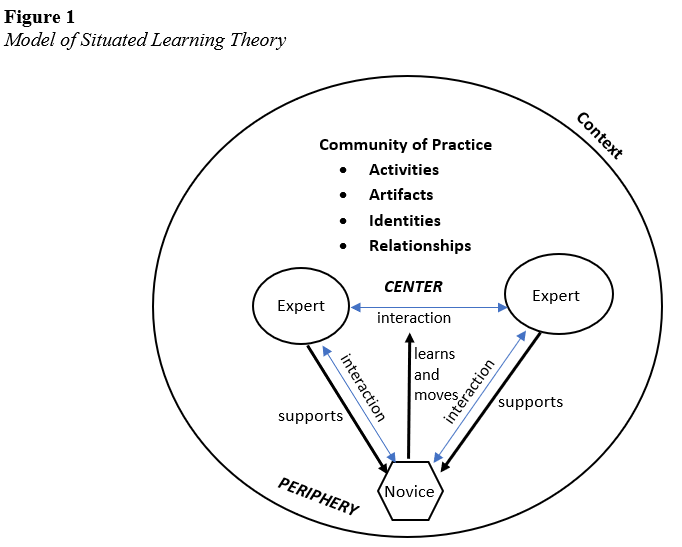Situated Learning Theory
Sandra P. Mina Herrera
Situated learning theory (SLT), first presented by Jean Lave and Etienne Wenger (1991), explains the process and development of learning when individuals have the opportunity to participate in a community of practice. In such a community, new learners reach the level of the expert as they have more opportunities to practice within the context of learning. In this light, learning is unintentional; this unintentional nature of learning is what the authors call Legitimate Peripheral Participation (LPP). In LPP, the learner moves from the periphery of the community to the center as he/she gains expertise and engages and participates actively in the sociocultural practices of the community (Lave & Wenger, 1991).
A similar theory is situated cognition, proposed by John Seely Brown, Allan Collins and Paul Duguid (1989). Their proposition goes deeper into the social nature of learning and argues that learning cannot be abstracted from the situations in which it is learned and merely be transferred or applied in school. In the view of both theories, knowledge is situated as the product of the activity, context, and culture in which it is authentically developed and used. The culture of conventional schooling influences what is learned, and decontextualized instruction does not lead to effective learning.
Previous Research
A number of studies focus on the effects of situated learning and student knowledge acquisition. For example, Zheng (2010) compared situated and traditional learning and found a positive correlation between situated learning and the learner’s performance. In another study, Bell and colleagues (2013) investigated the effectiveness of a teacher preparation program aligned with SLT in improving preservice science teachers’ use of technology during their student teaching experiences. The findings of this study suggest that situated learning theory may provide an effective structure for preparing preservice teachers to integrate technology in ways that support reform‐based instruction. Further, Catalano (2015) explored the efficacy of situated learning to facilitate the transfer of knowledge from an instructional situation to its application in environments outside the classroom. Their findings suggest that learning based in situated environments transfers more frequently and provides usable knowledge to real world contexts.
The Model

Concepts
The following concepts help to define SLT: (a) learning, the skills and knowledge gained as a result of participating in a community of practice; (b) context, the environment within which the situated aspect of learning occurs; (c) novice, the learner and newcomer in the community of practice who will learn from the experts around; and (d) experts, the set of individuals who know about the subject to be learned.
Constructs
Constructs include a community of practice, which pertains to the setting where learning occurs. The participants of the community are the learners and the experts. The relationships between these participants, as well as activities, artifacts, and identities, are also part of these communities (Lave & Wenger, 1991).
LPP describes the process by which newcomers become part of a community of practice and how they transition toward full participation in the sociocultural practices of the community. At first, learners participate from the periphery until they become more skilled and become experts.
Proposition
Learning does not occur exclusively by receiving decontextualized content and applying it later. Learning happens as a result of participating actively in a community of practice which includes LPP as its central defining characteristic. Learning occurs when it takes place in the context in which it is applied.
Using the Model
SLT has been used in school settings to improve teaching practice. It is important, however, to notice that although the school offers the social context for learning, it sometimes falls short in the application of this theory. The construction of knowledge needs to be embedded in a context where learners can actually participate and apply what is learned. The social aspect is not enough by itself. The nature of situated learning and the emphasis on LLP as a way to understand how learning develops can be applied in instruction to understand and design learning processes. As Lave and Wenger (1991) state, “Rethinking schooling from the perspective afforded by LLP will turn out to be a fruitful exercise” (p. 41).
The vast majority of research related to SLT explores the benefits and affordances of the theory in practice. There are still many ways that the model can be used and tested in research, including to ask the following questions:
-
Are there any other instances of learning that can benefit from situated learning? If so, which?
-
Can situated learning be applied in all subject areas? If so, how?
-
What instances of teaching should be explicit and which ones can stick to traditional instruction?
-
Is situated learning possible in online instruction? If so, what does it look like?
Conclusion
SLT brings to the table the importance of recognizing learning as a process that goes beyond the transmission of content. Factual knowledge and content per se do not lead to learning. The interaction of the learner and the expert in the community of practice and the evolution of the former into a level of expertise all together in a contextualized setting is what in the end supports knowledge construction.
References
Bell, R. L., Maeng, J. L. & Binns, I. C. (2013). Learning in context: Technology integration in a teacher preparation program informed by situated learning theory. Journal of Research in Science Teaching, 50, 348-379.
Catalano, A. (2015). The effect of a situated learning environment in a distance education information literacy course. The Journal of Academic Librarianship, 41(5), 653-659.
Brown, J. S., Collins, A., & Duguid, P. (1989). Situated cognition and the culture of learning. Educational Researcher, 18(1), 32–42.
Lave, J. & Wenger, E. (1991). Situated learning: Legitimate peripheral participation. Cambridge University Press.
Zheng, R. (2010). Effects of situated learning on students’ knowledge acquisition: An individual differences perspective. Journal of Educational Computing Research, 43(4), 467–487.
